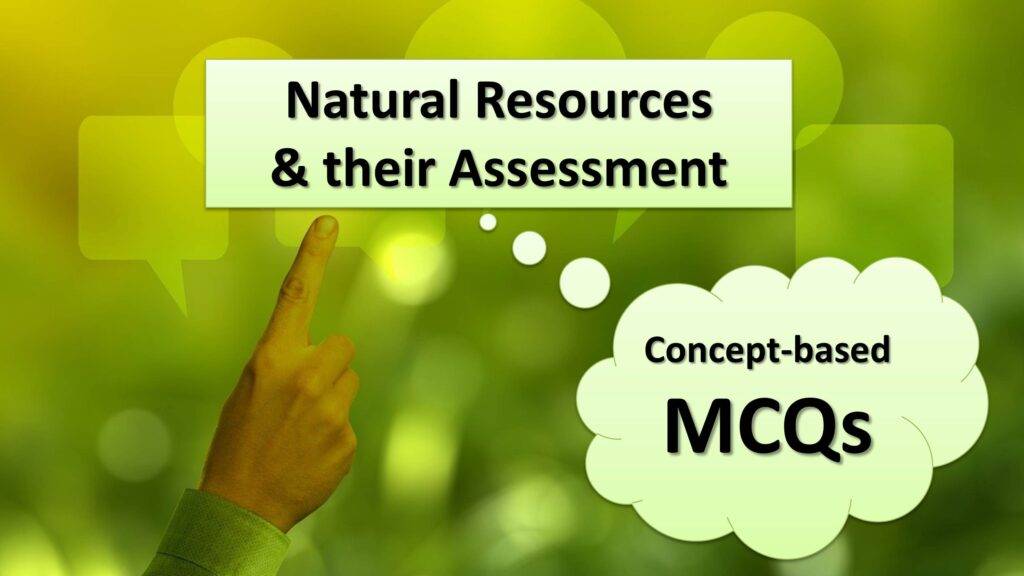
Welcome to the COMPETITIVE EXAM MCQs SERIES of ENVIRONMENTAL SCIENCE for UGC-NET/JRF, SLET, GATE, and other entrance tests – Natural resources and their assessment.
Syllabus outline
- Definition and types of natural resources (renewable and non-renewable).
- Types, distribution, and significance of Forest, Water, Soil, Wildlife, Fossil fuels, Minerals, and ores.
- Metallic and non-metallic resources: Iron, copper, gold, uranium, limestone, etc.
- Conventional energy sources: Coal, petroleum, natural gas – pros and cons.
- Alternative and renewable energy sources: Solar, wind, hydropower, geothermal, biomass – potential and challenges.
- Land use patterns: Agriculture, urbanization, industrialization, and their impacts.
- Land degradation and desertification: Causes and remediation measures.
- Water quality assessment: Physical, chemical, and biological parameters.
- Forest cover assessment: Remote sensing and GIS applications.
- Forest biodiversity assessment and monitoring.
- Techniques for mineral resource exploration and evaluation.
- Assessment of energy reserves and potential of renewable sources.
This quiz contains the concept-based most frequently asked 25 MCQs of “Natural resources and their assessment“. Each question has a single correct/most appropriate answer.
1. Which of the following describes resources that have not yet been discovered or assessed for potential use?
a) Proven resources
b) Known reserves
c) Undiscovered resources
d) Inferred resources
2. What would be the most appropriate step before proceeding with the natural gas extraction project from a region with a significant biodiversity?
a) Begin the extraction process and monitor any adverse effects on biodiversity later.
b) Conduct an EIA to evaluate potential impacts on the ecosystem.
c) Partnership with local communities to share the benefits of resource extraction.
d) Obtain permits from local authorities and start the extraction immediately.
3. The concept of resource curse refers to:
a) Abundant resources leading to economic prosperity.
b) The sustainable use of resources by developing nations.
c) Using resources as a tool for diplomatic relations.
d) The negative consequences of relying on non-renewable resources.
4. Which is the correct order for conducting a comprehensive Life Cycle Assessment of a resource?
1. Interpretation of results and reporting of findings.
2. Goal and scope definition of the LCA.
3. Inventory analysis of resource extraction and use.
4. Impact assessment of environmental, social, and economic factors.
5. Life cycle interpretation and improvement recommendations.
a) 1, 2, 3, 4, 5
b) 2, 3, 4, 5, 1
c) 2, 4, 3, 1, 5
d) 2, 3, 1, 4, 5
5. What is the primary objective of resource valuation when assessing natural resources?
a) To determine the market price of resources for profit maximization.
b) To estimate economic, social and environmental values to inform decision-making and conservation efforts.
c) To allocate resources to industries based on their economic contribution.
d) To calculate the cost of resource extraction and production.
6. What is the main objective of conducting a Life Cycle Assessment?
a) To evaluate the environmental effects of a product or process.
b) To determine the resource scarcity index.
c) To analyze the lifespan of a product.
d) To assess the impact of resource consumption on the economy.
7. Which of the following statements about non-renewable resources is true?
a) It is not affected by human consumption.
b) It can be replenished within a few decades.
c) It takes millions of years to form.
d) It cannot be replenished
8. How does reservoir capacity differ from recoverable reserves when assessing non-renewable resources?
a) Reservoir capacity refers to the total amount of natural resources, while recoverable reserves indicate the portion that can be extracted with existing technology.
b) Reservoir capacity focuses on the amount of a resource that can be extracted sustainably, while recoverable reserves consider the total stock of the resource.
c) Reservoir capacity refers to the portion of a resource that can be economically extracted, while recoverable reserves represent the total amount of a resource available.
d) Reservoir capacity refers to the resource’s availability in the future, while recoverable reserves focus on current extraction rates.
9. In an ecological assessment of a forest, researchers found that the diversity of plant and animal species increased significantly after implementing conservation measures. What does this indicate about the forest ecosystem?
a) The forest’s resources are overexploited.
b) The forest is experiencing an ecological overshoot.
c) The forest has a low ecological carrying capacity.
d) The forest is stable and resilient to disturbances.
10. What is the primary purpose of conducting a Resource Assessment?
a) To determine the market price of resources.
b) To evaluate the economic viability of resource extraction.
c) To estimate the total quantity of resources available.
d) To identify potential sources of resources.
11. The concept of resource partitioning refers to:
a) The extraction of resources beyond their sustainable yield.
b) The distribution of resources within an ecosystem to reduce competition.
c) The formation of resource-sharing agreements between nations.
d) The allocation of resources among different stakeholders.
12. What is the main drawback of using Gross Domestic Product as an indicator of a country’s economic well-being in relation to resource consumption?
a) It cannot be compared between countries.
b) It does not consider inflation rates.
c) It does not account for environmental impacts.
d) It only focuses on the service sector.
13. The concept of ecological debt refers to:
a) The debt incurred by governments for environmental projects.
b) The environmental impact of resource consumption.
c) Developed nations’ accountability for their ecological footprint on developing nations
d) The surplus of resources in an ecosystem.
14. How could an Integrated Water Resources Management approach benefit the region where water resources are limited?
a) It would implement a collaborative and coordinated approach to manage and allocate water resources among all competing sectors.
b) It would allocate all the water resources to the industry with the highest economic output.
c) It would discourage industrial activities that rely on water resources and focus on non-water-dependent industries.
d) It would prioritize access to water for industries that use the least water.
15. The concept of ecological overshoot refers to:
a) The continuous increase in the total resource stock.
b) The use of technology to increase resource availability.
c) The implementation of ecological conservation measures.
d) The depletion of renewable resources beyond their natural regeneration rate.
16. The concept of renewable resource potential refers to:
a) The time it takes for renewable resources to regenerate fully.
b) The maximum sustainable yield of a renewable resource.
c) The economic value of renewable resources.
d) The total quantity of renewable resources available.
17. Which assessment tool evaluates the impact of a project or activity on the environment, including its potential effects on resources?
a) Cost-Benefit Analysis
b) Life Cycle Assessment
c) Ecological Footprint Analysis
d) Environmental Impact Assessment
18. Which of the following terms refers to the maximum amount of a resource that can be sustainably harvested without depleting the resource stock?
a) Carrying capacity
b) Sustainable yield
c) Optimal extraction
d) Resource abundance
19. The concept of peak oil refers to:
a) The point when oil prices reach their highest level.
b) The peak season for oil consumption.
c) The point when global oil reserves begin to decline.
d) The maximum production capacity of oil wells.
20. What is the main challenge in assessing the value of ecosystem services provided by natural resources?
a) Lack of demand for ecosystem services
b) Limited knowledge of ecosystem functions
c) Overabundance of resources
d) Difficulty in quantifying their economic worth
21. A community is concerned about the environmental impact of a proposed mining project in their area. Which of the following actions should the community take to ensure their concerns are addressed?
a) Boycott the products produced by the mining company.
b) Participate in public consultations and raise their concerns based on scientific evidence.
c) Engage in peaceful protests to halt the project immediately.
d) Initiate a legal battle against the mining company.
22. What is the term used to describe the economic value of an individual’s or society’s willingness to pay to preserve or protect a resource?
a) Non-use value
b) Market value
c) Intrinsic value
d) Ecological value
23. Which process evaluates the economic, environmental, and social impacts of a resource throughout its entire life cycle?
a) Ecological Impact Evaluation
b) Resource Assessment
c) Cost-Benefit Analysis
d) Life Cycle Assessment
24. Assertion (A): Conducting a comprehensive Life Cycle Assessment (LCA) is essential for sustainable resource management.
Reasoning (R): LCA helps to evaluate the environmental, social, and economic impacts of a resource from its extraction to its end-of-life stage, aiding in informed decision-making.
a) Both A and R are true, but the R is not the correct explanation of the A.
b) A is false, but the R is true.
c) A is true, but the R is false.
d) Both A and R are true, and the R is the correct explanation of the A.
25. Which describes the proportion of the total resource stock that can be technically and economically extracted with existing technology?
a) Reservoir capacity
b) Exploration potential
c) Recoverable reserves
d) Carrying capacity
Previous: Interaction between Earth, Humans and Environment
Next: Bio-geographic provinces of the world
References
- S. Manikandan (2018) Environmental Science and Natural Resources Management, S. Chand Publishing, 1st edition
- Richard T. Wright and Dorothy F. Boorse (2017) Environmental Science: Toward a Sustainable Future, Pearson, 13th edition
- Erach Bharucha (2017) Environmental Studies, Universities Press, 4th edition
- Anil K. Tyagi (2018) Environmental Science and Engineering, Khanna Publishers, 3rd edition

